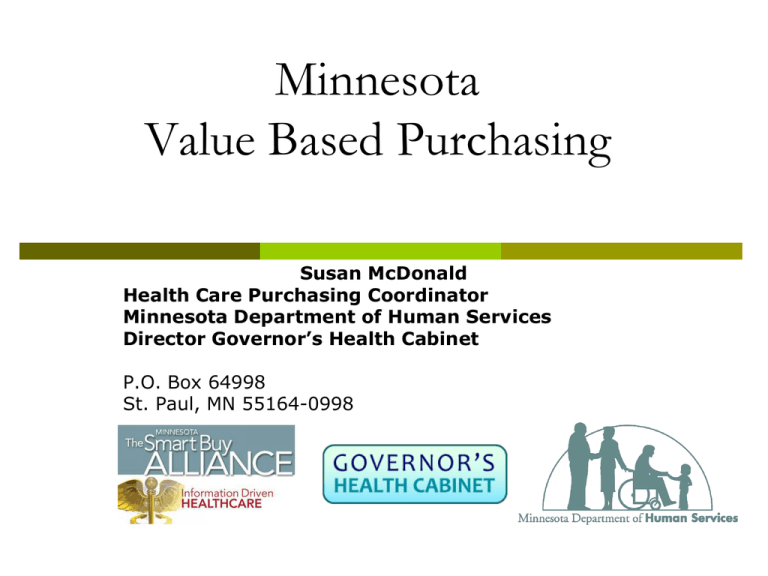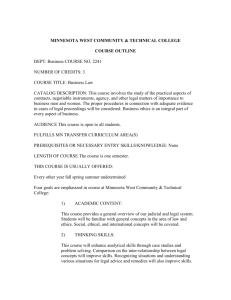Minnesota Initiatives to Improve Health & Create Patient
advertisement

Minnesota Value Based Purchasing Susan McDonald Health Care Purchasing Coordinator Minnesota Department of Human Services Director Governor’s Health Cabinet P.O. Box 64998 St. Paul, MN 55164-0998 Background: Governor’s Health Cabinet State government working as a team: 5 agencies regulating or purchasing health care Purchases health care for 800,000 Minnesotans, 20% of population Engaged in array of private-public alliances and partnerships to create a value driven health care market. Mission Statement: Take on the state’s health care costs issues by using its buying power to make substantive changes to Minnesota’s health care market. Minnesota Model to Value Driven Health Care Value vs. Volume Volume = Number of office visits, procedures, hospital admissions x price Value = Access + Service + Outcome Price / Time Transparency of price and quality Electronic information exchange Improving health status of Minnesotans Engage consumers- Engage consumers- Engage consumers Minnesota Advantage Plan Tiered health benefits plan for state employees Clinic systems placed into 1 of 4 cost level If a higher cost level provider is selected, the user pays more at the point of service Based on risk adjusted costs and collective bargaining Risk adjustment -- apples to apples comparisons Higher copays, deductible, coinsurance Quality information provided via links to MN Community Measurement website 4 Advantage’s key features Information and incentives: Employees and families to choose high quality, high value providers Providers to deliver greater value, or lose market share Use health care wisely and protect/improve health Saved $30M+ in first year! 5 Advantage – How it Works Administration Self-funded program Multiple health plan administrators are used to: Negotiate provider contracts and manage network Perform core functions such as claims adjudication Monthly Cost Premium is the same for all provider groups and administrators When members elect a more expensive cost level, they pay greater cost sharing each time they receive services 6 Recognition Received “Innovations” Award by the Council of State Government - 2004 7 Premium Trends 2006 – 0% - Lost $20M to premium holiday 2007 – 9.9% 2008 – 6.7% - Lost $16M to HRA 2009 – 3.5% 2010 – 0% 2011 – 6.7% - Lost $8M to HRA Partnering with the Private Sector “Smart Buy” Alliance Minnesota Smart Buy Alliance was created to: Define the reason for the gap between cost and quality Focus purchaser efforts to common market signal No more cost shifting between buyers; rather use buying power to effect change across entire market Use common principles and goals in buying health care Require or reward “best in class” certification Adopt uniform measures of quality and results Require the latest information technology Empower consumers with easy access to information Minnesota’s Health Care Environment One of the lowest # of uninsured in nation – 7.2% Healthiest state in nation 4 of last 5 years Most state-wide tools in marketplace Most use of health savings accounts – 9.2% Most purchase of LTC insurance – 10% (over 50 years) More integrated systems (hospitals & clinics) More primary care physicians / citizen More employer sponsored insurance Not for profit HMO’s Collaborative history Tools Needed to Get Us Where We Are Today [minnesotahealthinfo.org] ICSI MN Community Measurement Adverse Event Institute for Clinical Systems Improvement – private sector developed standards and practice guidelines Measurement and reporting of quality and price information Reporting eValue8 QCare / P4P Common standards of payment Tiered plans Peer grouping of providers + centers of excellence Health Savings Accounts Disruptive providers Measurement of health plan performance As market driver Convenience and employer clinics, alternate care, navigators Connecting the Consumer to the Tools! Electronic Information Exchange Minnesota HIT Goals E-prescribing for all providers, plans, pharmacies by 2011 Uniform administrative transaction required by 2009 Interoperable electronic health records by 2015 Governor Pawlenty initiative to provide personal health portfolios for all state employees by 2009, all Minnesotans by 2011 Minnesota HIT Environment Minnesota Health Information Exchange Vision is to link providers to exchange clinical information in a secure and efficient way Includes private partners and DHS as an investor Launched in fall 2008 with Rx history Discussions with technology partners to connect the consumer and physician The Minnesota e-Health Initiative A public-private collaboration established in 2004 Legislatively chartered Coordinates and recommends statewide policy on e-health Develops and acts on statewide e-health priorities Reflects the health community’s strong commitment to act in a coordinated, systematic and focused way “Vision: … accelerate the adoption and effective use of Health Information Technology to improve healthcare quality, increase patient safety, reduce healthcare costs, and enable individuals and communities to make the best possible health decisions.” 14 Source: e-Health Initiative Report to the MN Legislature, January 2004 The Value Equation Value = Access + Service + Outcome Price / Time Health IT Interoperability Clinical exchange –MnHIE Patient control/owned health information- life long personal health records The Tipping Point: Giving consumers the information necessary for creating a health life! Connecting: Family Health History Family Health Management and Support Medical Providers Fitness Health Monitoring Devices Financial Management Social Networking Search for Information Health Benefits Health Assessment Biometric Screening Disease Management And much more….





